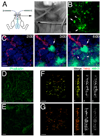Intravital two-photon microscopy for studying the uptake and trafficking of fluorescently conjugated molecules in live rodents
- PMID: 18647170
- PMCID: PMC2711521
- DOI: 10.1111/j.1600-0854.2008.00798.x
Intravital two-photon microscopy for studying the uptake and trafficking of fluorescently conjugated molecules in live rodents
Abstract
In this study, we describe an experimental system based on intravital two-photon microscopy for studying endocytosis in live animals. The rodent submandibular glands were chosen as model organs because they can be exposed easily, imaged without compromising their function and, furthermore, they are amenable to pharmacological and genetic manipulations. We show that the fibroblasts within the stroma of the glands readily internalize systemically injected molecules such as fluorescently conjugated dextran and BSA, providing a robust model to study endocytosis. We dynamically image the trafficking of these probes from the early endosomes to the late endosomes and lysosomes while also visualizing homotypic fusion events between early endosomes. Finally, we demonstrate that pharmacological agents can be delivered specifically to the submandibular salivary glands, thus providing a powerful tool to study the molecular machinery regulating endocytosis in a physiological context.
Figures




Similar articles
-
Intravital microscopy to image membrane trafficking in live rats.Methods Mol Biol. 2013;931:153-67. doi: 10.1007/978-1-62703-056-4_9. Methods Mol Biol. 2013. PMID: 23027003 Free PMC article.
-
Intravital Imaging of Vascular Permeability by Two-Photon Microscopy.Methods Mol Biol. 2021;2223:151-157. doi: 10.1007/978-1-0716-1001-5_11. Methods Mol Biol. 2021. PMID: 33226593
-
Maturation of early endosomes and vesicular traffic to lysosomes in relation to membrane recycling.J Cell Sci. 1995 Apr;108 ( Pt 4):1791-803. doi: 10.1242/jcs.108.4.1791. J Cell Sci. 1995. PMID: 7542261
-
The Use of Intravital Two-Photon and Thick Section Confocal Imaging to Analyze B Lymphocyte Trafficking in Lymph Nodes and Spleen.Methods Mol Biol. 2018;1707:193-205. doi: 10.1007/978-1-4939-7474-0_14. Methods Mol Biol. 2018. PMID: 29388109 Review.
-
Intravital multiphoton microscopy as a tool for studying renal physiology and pathophysiology.Methods. 2017 Sep 1;128:20-32. doi: 10.1016/j.ymeth.2017.07.014. Epub 2017 Jul 19. Methods. 2017. PMID: 28733090 Free PMC article. Review.
Cited by
-
Polyethylenimine-mediated expression of transgenes in the acinar cells of rats salivary glands in vivo.Front Cell Dev Biol. 2015 Jan 9;2:74. doi: 10.3389/fcell.2014.00074. eCollection 2014. Front Cell Dev Biol. 2015. PMID: 25621283 Free PMC article.
-
Non-invasive intravital imaging of head and neck squamous cell carcinomas in live mice.Methods. 2017 Sep 1;128:3-11. doi: 10.1016/j.ymeth.2017.07.026. Epub 2017 Aug 3. Methods. 2017. PMID: 28780320 Free PMC article.
-
Clathrin-independent endocytosis: a cargo-centric view.Exp Cell Res. 2013 Nov 1;319(18):2759-69. doi: 10.1016/j.yexcr.2013.08.008. Epub 2013 Aug 13. Exp Cell Res. 2013. PMID: 23954817 Free PMC article. Review.
-
Intravital microscopy to image membrane trafficking in live rats.Methods Mol Biol. 2013;931:153-67. doi: 10.1007/978-1-62703-056-4_9. Methods Mol Biol. 2013. PMID: 23027003 Free PMC article.
-
Linking differences in membrane tension with the requirement for a contractile actomyosin scaffold during exocytosis in salivary glands.Commun Integr Biol. 2012 Jan 1;5(1):84-7. doi: 10.4161/cib.18258. Commun Integr Biol. 2012. PMID: 22482019 Free PMC article.
References
-
- Mellman I. Endocytosis and molecular sorting. Annu Rev Cell Dev Biol. 1996;12:575–625. - PubMed
-
- Conner SD, Schmid SL. Regulated portals of entry into the cell. Nature. 2003;422(6927):37–44. - PubMed
-
- Maxfield FR, McGraw TE. Endocytic recycling. Nature reviews. 2004;5(2):121–132. - PubMed
-
- Helmchen F, Denk W. Deep tissue two-photon microscopy. Nat Methods. 2005;2(12):932–940. - PubMed
MeSH terms
Substances
Grants and funding
LinkOut - more resources
Full Text Sources
Miscellaneous

